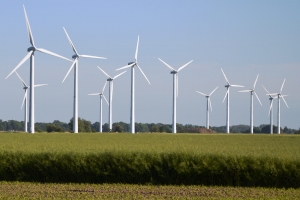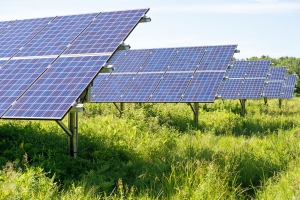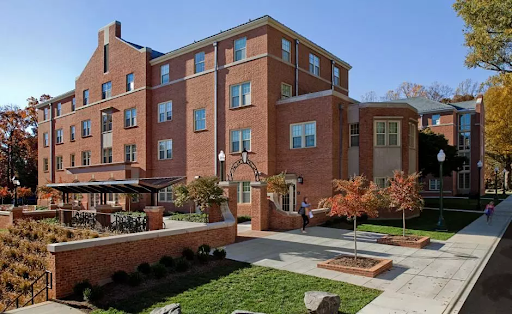The Road to Reducing Climate Impact Starts Here

All climate actions plans, from universities to transnational corporations, start in the same place: building and plant efficiency. Wake Forest’s investments in energy efficiency started, in earnest, in 2007. This is the baseline year from which all greenhouse gas reductions on campus are measured. A task force at Wake Forest is engaged in the process of evaluating scenarios for a full climate action plan, to be released in fall 2019. This article outlines the work of the task force.
Square footage up; energy use down
Though the university’s building footprint has grown by 40% — or 1,445,962 gross square feet — since 2007, energy use has only increased by 3%. The growth, which is made up of new construction and acquisitions (including properties like the LJVM Coliseum), has been offset by a 27% reduction in energy intensity — from 148 to 109 kBtus per gross square foot. Energy use is characterized in British thermal units, or Btus, so that electrical, heating, and cooling utilities all share a common measurement unit.
These investments in energy efficiency are important to the university’s long-term financial sustainability. They’re even more important to the accounting spreadsheets that track our greenhouse gases and resultant climate change impacts.

The plan in three steps
Carbon action planning is a matter of 1) determining how much reduction in energy intensity is feasible, then 2) developing a strategy to switch from carbon-intensive fossil fuels to lower-emitting options, and finally, 3) offsetting the remaining emissions through renewable energy credits, greenhouse gas mitigation, or carbon sequestration. Together, these three steps lead to carbon neutrality.
At Wake Forest, Facilities and Campus Services forecasts the potential for at least a 45% overall reduction in greenhouse gas impacts, with the potential for nearly 50%, by 2027. This target is informed by building and enrollment projections, efficiency investment plans, and changes in the mix of fuels that power the campus.
Step 2: renewable energy — opportunities and obstacles
Duke Energy, the university’s electric utility provider, generates electricity from about a third coal, a third natural gas, and a third nuclear sources. Since 2007, Duke Energy has reduced the greenhouse gas intensity of its generation mix by 35%. The company has also invested in 6 solar-generating facilities in North Carolina.
According to Project Drawdown, a catalog of the 80 most impactful solutions for reversing climate change, the electricity generation sector currently accounts for around 40 percent of annual global greenhouse gas emissions, making it the highest-emitting sector in the world. Although the cost competitiveness of fossil-free generation sources has increased dramatically, opportunities in North Carolina are limited.

#2: Project Drawdown ranks solutions according to global impact by 2050, if implemented by 2020. The second ranked solution on the list is the development of onshore wind. Unfortunately, onshore wind speeds in the NC Piedmont are not high enough to make this a regionally appropriate solution.

#22: Coming in at #22 on the list, offshore wind could produce at least 20% of North Carolina’s energy needs, but faces some political obstacles in the state. NC State Senate Majority leader, Harry Brown, who led an 18-month moratorium on on-shore wind that expired earlier this year, continues to express concerns that off-shore wind development would obstruct military training exercises. The Department of Defense has a goal of sourcing 25% of energy requirements from renewables by 2025, so off-shore wind will likely have a future role in NC.
#8: The eighth most impactful solution would be the development of solar farms. Wake Forest would need approximately 25 acres of solar farm development to offset our electricity demand. Traditionally, this would be accomplished through a direct power purchase agreement, or PPA. In a direct PPA, a renewable energy developer generates electricity and sells the electrons directly to a user – often a non-profit entity like a university – over a set number of years, at a set price. Direct PPA’s, however, are currently illegal in North Carolina. NC HB 589 came close to loosening the restrictions on this direct delivery model last year.


#10: The tenth solution on the list is rooftop solar. The Wake Forest Reynolda Campus has a peak electric demand of 10 megawatts (MW). Tony Schallert, Wake Forest’s facilities infrastructure engineer, worked with an industry consultant to analyze available rooftops on all campus properties for the feasibility of solar photovoltaic installations and identified 1.5 MW of eligible roof space at a cost of about $3 million.
As non-profit entities, universities are not eligible for renewable energy tax incentives, so Wake Forest’s initial investment would not be offset by tax credits in the same way it would be for a private investor. Therefore, the consultant recommended a solar leasing contract. NC HB 589 capped solar leasing at 1 MW, so the study further identified the most viable roof space for 1 MW of generating capacity. Once the North Carolina Utilities Commission finalizes the new leasing rules, North Carolina can invite qualified commercial lessors into our market. From that point, design and construction on campus would take about two years.
Indirect (Virtual) PPA investment option
Some universities have opted to invest in renewable energy in spite of the obstacles. While direct PPA’s are illegal, or just difficult in states, including North Carolina, a new investment option is growing in popularity. Vanderbilt, University of Richmond, George Washington, and American University, among others, have turned to indirect (virtual) PPA’s. As the name implies, an indirect PPA is a financial investment in renewable energy that does not result in renewable energy flowing directly to the campus. In making this investment, a university takes responsibility for generating renewable energy and selling it through a wholesale market in the region where it is developed. This allows the university to take credit for renewable energy generation while direct on-site generation opportunities become available. Evaluation of this option for Wake Forest will fall to members of the task force.
Finally, carbon offsets
Carbon offsets are calculations of an activity’s ability to reduce or sequester carbon emissions. Offset activities include urban tree planting initiatives, reforestation efforts, methane capture from landfills or animal manure, and renewable energy generation. Each activity must meet a verifiable calculation protocol. Duke University has a robust carbon offset initiative that will take that university to its goal of carbon neutrality by 2024.

Our competition, so to speak
Among Wake Forest’s peer schools, greenhouse gas reduction targets vary. Duke, UNC Chapel Hill, George Washington, Washington & Lee, and the University of Richmond all have plans to reach carbon neutrality by 2050; Duke University plans to reach neutrality by 2024. Tufts, Davidson, Emory, and UVA have all pledged incremental decreases similar to Wake Forest’s current projections.
The list of universities achieving their renewable energy and carbon neutrality goals, several ahead of schedule, increases daily across the US and Canada.
